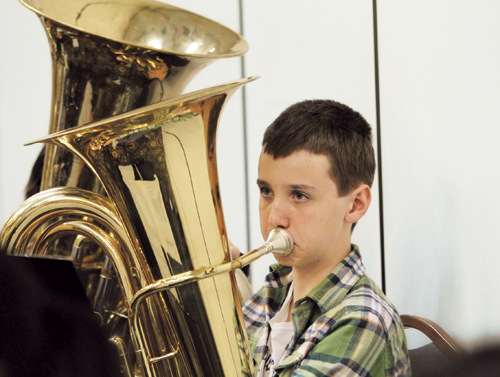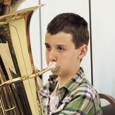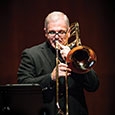
The tuba is an essential part of the band sound, but selecting, training, and retaining good tuba players can be exceedingly difficult. The following ideas will help to ensure that tubists have the best possible start to their musical endeavors while laying the groundwork for continued development and success.
Selling Students on the Tuba
The tuba can be a hard sell during instrument selection. While initial play-testing of instruments will help identify students with the requisite physical makeup for tuba playing, if those students also show promise on other instruments, it might be difficult to overcome negative impressions and stereotypes and convince them to choose the tuba. The same problem exists when students start on another brass instruments and are later asked to switch to tuba; selling those students on the idea of switching can be difficult, and exhortations about the importance of the tuba sound might ring hollow.
One step to overcoming these difficulties is to have recordings of fine tuba players on hand or to direct students to streaming services that have such recordings available. Recordings by great tubists like Gene Pokorny, Jim Self, Roger Bobo, and David Zerkel can go a long way toward convincing students that the tuba is a worthy instrument that possesses a beautiful sound in skilled hands. Continue to use such recordings as models for students to emulate as they develop.
Choosing Instruments
Even the best recordings might fail to persuade students to choose the tuba if available instruments are difficult to manage or in disrepair. At one time it was not uncommon for beginning tubists to be placed on the Eb tuba, a practice that I wish could be resumed. These smaller and shorter instruments were in some respects easier for young players to manage than the BBb tuba.
Still, manufacturers do include small-sized BBb tubas in their catalogs, and these should be used if at all possible. Instruments such as the Yamaha YBB-105, King 1135, and Jupiter 378 are designed with younger students in mind; they have narrower bores and smaller dimensions that help students to hold and play the instrument more easily. If purchasing smaller instruments for beginners is not possible, tuba stands can help students to manage the larger instruments. Regardless of the age of instruments available for beginners’ use, keeping the instruments clean and in good working order will help students to play better and feel more enthusiastic about switching.
Choosing Mouthpieces
One of the most common – and unnecessary – difficulties I observe with young tubists stems from the use of inappropriately large mouthpieces. The Conn Helleberg is a very common choice, and while it is a fine mouthpiece for older, more developed players, it is on the larger end of available tuba mouthpieces and can be difficult for beginning students to play. If the Helleberg style is desired the Schilke Helleberg is a good bit smaller and thus more manageable, and the Conn Helleberg 7B lies between the two extremes. The Bach 25 and Wick 4 are smaller than any of these; while these may not be good choices for older students, something that small might be helpful to new tubists just getting their feet wet. Some confusion regarding tuba mouthpieces is understandable, as sizing and labeling of mouthpieces from different manufacturers lacks the standardization found among trumpet and trombone mouthpieces.
Breathing
The development of adequate breathing is important for all wind players but is especially so for tubists. Hopefully you are already having the entire band perform breathing exercises, such as those found in The Breathing Gym by Sam Pilafian and Patrick Sheridan, on a regular basis. Such exercises need not take a great deal of class time; even a couple of minutes of breathing exercises at the beginning of rehearsal will improve the entire band sound. For tuba players, these exercises are necessary to make great playing possible.
Beyond breathing exercises, I recommend that beginning tubists be required to play phrases of no longer than two bars in 44 time. While having beginners on other instruments strive for four-bar phrases is usually appropriate, young tubists will likely be able to play these longer phrases only with a weak and uncharacteristic sound. Instead, encourage them to play out, and allow more frequent breaths. (Conversely, make sure that the tuba players are not breathing too frequently; some will breathe after every note if not corrected.)
Tone Quality
Although this expression can become clichéd, the tubas do form the foundation of the band’s overall sound, and a full and robust tone should be encouraged at all times. As already mentioned, providing examples of great tuba playing and facilitating proper breath development and management will go a long way toward enabling students to achieve this sound. Furthermore, encourage students to fill the entire mouthpiece with buzz. The more lip surface vibrating inside the mouthpiece, the fuller and richer the resulting sound will be. Having students imitate a horse and then replicate that feeling inside the mouthpiece will give them an idea of how this should feel.
Teachers must be vigilant to make sure tubists are playing with a full sound. While uncharacteristic sounds from higher-pitched instruments can be shrill and thus command immediate attention, a lacking tuba sound is usually mellow and difficult to notice.
Articulation
Teaching young brass players to articulate properly should be kept as simple as possible. Having students say tah or perhaps too will produce the desired result in most cases, but with tubists, a more open vowel such as oh or aw will better facilitate the desired tone quality, particularly in the lower register. Additionally, a softer consonant (doh or daw) is often appropriate, as this removes from the attack a certain forcefulness that can destabilize the tubist’s already relaxed embouchure.
Music Selection
While the band’s earliest music will likely consist of unison exercises and short pieces, as the repertoire advances a disparity quickly develops between the difficulty levels of parts for traditionally melodic instruments and those for the low brasses. Make an effort to find at least some music for the band that includes interesting and challenging tuba parts. This will help to emphasize and develop the concepts discussed, and might even improve retention of tuba players, who can be prone to quit band out of boredom. Encouraging private lessons and solo and chamber music is also helpful in this regard. While a little extra effort can be needed to provide them with healthy challenges, doing so will ensure that young tubists develop into engaged and capable musicians. l






